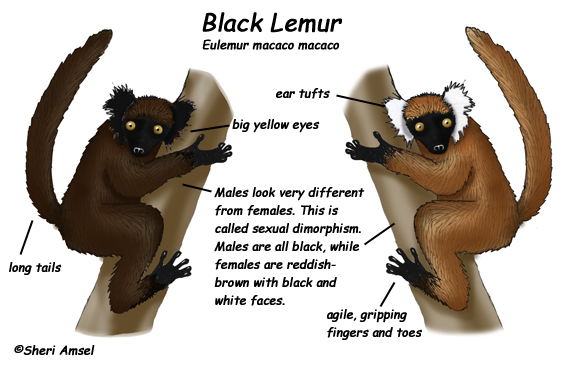

They are found on the island of Madagascar.
They live in tropical forests and agricultural areas.
They weigh about 5 pound (2.5 kg). Males look very different from females. This is called sexual dimorphism. Males are all black, while females are reddish-brown with black and white faces. They have tufts of fur over the ears. They are more than 3 feet long (95 cm), including tail.
They live in small groups and are active mostly at night (nocturnal).
They eat insects, leaves, flowers and fruit and bird eggs.
They are endangered. They are killed by snakes eagles, fossa and man.
Females are pregnant for 6 months (gestation) and have 1-2 babies.
They can live more than 25 years. They are listed as a "vulnerable" species.
Kingdom: Animalia
Phylum: Chordata
Subphylum: Vertebrata
Class: Mammalia
Order: Primates
Suborder: Strepsirrhini
Family: Lemuridae
Genus: Eulemur
Species: Eulemur macaco
When you research information you must cite the reference. Citing for websites is different from citing from books, magazines and periodicals. The style of citing shown here is from the MLA Style Citations (Modern Language Association).
When citing a WEBSITE the general format is as follows.
Author Last Name, First Name(s). "Title: Subtitle of Part of Web Page, if appropriate." Title: Subtitle: Section of Page if appropriate. Sponsoring/Publishing Agency, If Given. Additional significant descriptive information. Date of Electronic Publication or other Date, such as Last Updated. Day Month Year of access < URL >.
Amsel, Sheri. "Lemur (Black)" Exploring Nature Educational Resource ©2005-2024. December 14, 2024
< http://www.exploringnature.org/db/view/Lemur-Black >

